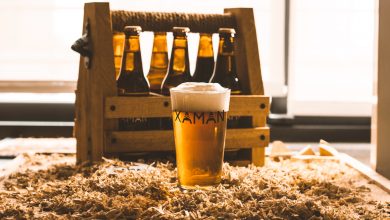The Biggest Beer Brewing Nations In The World

Anybody care for a cold one?
Beer is the most celebrated drink in the entire world. Don’t take our word for it; there are several researches that give the same conclusion.
Millions of people grab a bottle after a long day’s work, put up their legs, and chug at a cold one. You may be one of them. We certainly are. But have you ever wondered where that delicious brew you’re holding in your hand, actually comes from?
Well, there are the obvious guesses of Germany and the US. But truth be told, you’d never even guess some of the biggest beer brewing nations in the world.
The first in our list, in order from largest to smallest, is testimony to that:

China
The People’s Republic of China is renowned for its silks, technology, noodles, and smart people. But you may be surprised that this nation is also the largest producer of beer on the planet.
Archaeological studies show that beer was produced in China as far back as 7000 BC, when villagers would brew the golden liquid in their homes. Of course, it was much different compared to what we call beer today.
China is a very geographically diverse country. Every type of environment, from cold polar mountains to warm plateaus, calls it home. This gives the country the distinct advantage of brewing beers that cater to diverse palates. Brewed using locally-grown ingredients like rye, wild honey, rice, hawthorn fruits, sorghum, and grapes, the beer made in China boasts of a sweeter, more earthy flavor compared to other beers.
Commercial production started in the 1900s, and although the rice was still the major ingredient in Chinese beer, today, it is largely replaced by hops and barley. Between May 2018 and May 2019, the country produced over 3,639,000 kilolitres of beer. It is also the largest consumer of beer, at 45.7 billion liters – almost double the size of its immediate competitor, the USA.
Some of the most popular Chinese beer brands include Snow, Yanjing, Shancheng, PearlRiver, Tsingtao, Pabst Blue Ribbon, WuSu, Jinxing Kingstar, Yalaso, and the Tibetan Pale Ale.
United States
The first runner-up in this list is none other than the United States of America. But the US is still number one in its own right.
Although China has larger production figures, America is home to the highest number of breweries on the planet. There are over 7,450 breweries in the region, of which 6,266 are considered craft breweries.
When it comes to producing beer, Native Americans had been brewing a version of beer using corn for centuries. But the first immigrants to do so were the colonists in Virginia, who started making corn-based beer in 1587. In 1612, the country’s first brewery opened in Manhattan, and since then, there’s been no looking back.
In 2018, the US exported over 202.2 million barrels of beer and 2.3 million barrels of cider overseas. Even domestically, retail sales of beer have grown. Till 2017, a large part of this market belonged to large-scale brewers. However, now over nine percent of the market belongs to microbreweries.
In terms of taste, American beer is a lot blander than other beers. This can be attributed to the extensive use of corn, molasses, and wheat – ingredients that don’t have a distinct taste. Still, many brewers are trying to break the cycle and brew more flavourful beer. This strategy is working, since 40 percent of the American population claims the hop-based brew is their favorite beverage.
Of all the brands that are a huge hit in the US, these are the standout favorites – Bud Light, Coors Light, Budweiser, Miller Lite, Corona Extra, Heineken, and Modelo Especial.

Brazil
The land of beaches and beautiful people, Brazil is also renowned for its amazing beer. The country boasts of verdant fruit and spice-filled forests, which make for amazingly delicious beer.
Today, the nation produces over 3.5 billion gallons of beer every year. But the legacy of brewing in Brazil is more than 200 years old. It started when German immigrants introduced their love for beer and brewing to the locals in the 1830s. Shortly after, breweries were set-up in the city of Blumenau, and commercial production began. Incidentally, Blumenau is the only place outside Germany where Oktoberfest is celebrated at such a grand scale.
The very first Brazilian beer is Bohemia (now owned by Anheuser–Busch InBev), and it’s still in production and enjoyed by locals. Just like traditional German beer, most of the macro Brazilian beers also champion Pilsners, Hefeweizens, Blocks, and more. But when it comes to microbrews and craft beer, Brazil gets creative. From chocolaty to citrusy to honey, you can find all types of beer here.
Some of the most popular beers drunk in Brazil include Cintra, Bohemia, Brahma, Skol, Antarctica, Xingu Black Beer, and Original; plus beers from breweries like Jeffrey, 2cabeças, Cervejaria Nacional and Hocus Pocus. Itaipava is the cheapest beer on the market – a drink of the masses.
Germany
No country in the world is as steeped in beer history as Germany. The country is the fourth-largest brewer in the world – having produced and sold over 93.65 million hectolitres in 2018 (and 6.8 million hectolitres of beer in August 2019 alone). Deutschland is also a very large beer consumer – the third biggest on the planet.
Beer brewing began in Germany around 500 years ago. In 1516, the country’s very first beer regulation, Reinheitsgebot (Purity Law), came into existence, followed even today. To qualify as a true German beer, the beer must be brewed only using hops, barley, yeast, and water.
German brewers follow a particular beer style guide when producing their beer. There’s the springtime Gose with its fruity and salty flavour, the dark and malty Dunkelweizen, the coppery Doppelbock with its chocolate and caramel notes, the classic zesty Pilsner, the Kottbusser with its oats & honey, and the Roggenbier that tastes like banana-clove-vanilla, amongst others. Every German beer has its own flavor profile, and they have made their way all over the world.
When it comes to the most famous beers in Germany, we can’t ignore brews like Kristall, Spaten Oktoberfest, Paulaner, Aecht Schlenkeria Rauchbier, Eisbock, Kölsch, Berliner Weisse, and Radeberger Pils. They’re all delicious and brewed in accordance with Reinheitsgebot.
When we talk of beer in Germany, we have to mention German beer traditions. For example, did you know that toasting before a drink is essential in Germany? Always keep eye contact with the person you’re toasting, or else bad luck will befall you for years to come.
Then, of course, is the world-famous Oktoberfest. If you’re heading there, brush up on your Chicken Dance – it’s the festival’s main and staple dance.
Russia
Vodka. That’s the word that first comes to mind when we think of Russia. Cold, snowy nights and shots of vodka. Not frothy beer in a large glass.
But as it turns out, Russia is slowly becoming one of the biggest beer brewers and beer consumers in the world. In 2018, the country produced 794.838 million dekaliters of beer – a 4.1 percent YOY-growth. Even in terms of consumption, Russia has outpaced most nations. Today, beer is slowly overtaking vodka in preference. While beer sales domestically have increased by 40 percent between 2001 and 2011, vodka sales have fallen by a staggering 30 percent.
This is surprising given that the history of beer in Russia is fairly short. While macro brands had been supplying to the region since the past few decades, craft beer production really took wing in 2009, with the arrival of BrewDog, a Scottish brewery. Till then, only a handful of breweries were present in Russia, brewing English style ales and pilsners. Following the arrival of the Scots, locals set-up their own breweries and started beer production. English pale ale, raspberry porter, and stouts were the favored notes. You’ll also find a lot of pale and dark lager on sale here.
If you’re looking to try the best craft beer in Russia, you should definitely get your hands on the brews by the following breweries – Jaws, Bakunin, Odna Tonna, Labeerint, Vasileostrovskaya, and Victory Art Brew. Apart from these are the classic Russian favorites like Baltika, Volkovskaya IPA, Zhigulevskoe, Klinskoye, Mokhnaty Shmel and Okhota Krepkoe.

Mexico
The land south of the United States also makes an entry on this list of the world’s most beer brewing nations. But unlike the German-inspired American beer, Mexico’s beers also contain hints of spices, fruits, and honey that the region is renowned for.
Beer brewing in Mexico started in the 19th Century. The Spanish were the first to introduce the golden liquid to the locals during colonization in the 16th Century. However, unable to get the required sanctions from the government to set-up a brewery in Mexico, the brewing culture was delayed for a few centuries.
The very first instance of Mexican beer production can be seen after the country’s independence. Soon after, the industry grew tremendously, and in 2018, the country produced over 110 million litres of beer. By June 2019 alone, Mexico had generated a whopping ?17 billion in beer exports and domestic sales combined.
The most consumed beers in Mexico include Tecate, Negra Modelo, Victoria, Pacifico, Modelo Especial, Calidad, Bohemia, Dos Equis, and Sol. Apart from these are the craft beers that Mexico is becoming famous for. Some of the breweries you need to visit are Baja Brewing Company, Chela Libre, Tempus, Cinco de Mayo, María Bonita, and Cucapá.
The culture of beer cocktails has also taken over Mexico. While purists will purse their lips in disapproval, those who don’t mind can try a glass of Micheladas or Chelada.
Japan
The island nation of Japan was first introduced to beer in the Edo period – the 17th century – when Dutch sailors landed on the shores of Nagasaki. While the initial types of beer sold in the country were global macro brews, by 1869, Japan had its first brewery in Yokohama. This was quickly followed by a brewery in Sapporo in 1876. Two of Japan’s most loved beers – Kirin and Sapporo – were developed in these places.
While initially the country produced just a few thousand barrels of beer, today, Japan now produces beer in the billions. In 2017, the country produced and sold 2.7 billion liters of beer. As a country that predominantly eats rice, the beer here is mostly rice-based. You can even find tangerines, miso, and smoked barley in some of the brews. Of course, new age brewers have started experimenting with other ingredients; however, on the whole, Japanese beers either have a natural sweetness or a sharp bitterness, nothing in between.
Some of the best-loved brews in Japan come from brands like Asahi (the Super Dry variant is Japan’s most drunk beer), Kirin (both the lager and the Ichiban Shibori), Suntory (Premium Malt), Sapporo (Yebisu Beer and Nama Beer Black Label are the most bought), and Hitachino (Nest White Ale).
In terms of craft beer, most of the breweries in Japan use ingredients like blueberries, blackberries, buckwheat, spice, and nuts, which give a delicious flavor to the beer. Some of the must-try craft brews include Shigakogen, Yona Yona, Swan Lake, Sankt Gallen Shonan Gold, Minoh, and Imperiality.
United Kingdom
Beer lovers will have, at some point in their lives have tasted the traditional English ale. But the fact is, the UK beer industry has a lot more to offer than this.
Beer brewing has been part of the UK’s legacy for a thousand years. In fact, beer can be considered the lifeblood of the UK. In 1188, King Henry II put a tax on beer (Saladin Tithe), which essentially paid for the Crusades. At this time, the beer was un-hopped.
But by the time commercial production started in 1412, buyers disliked the traditional un-hopped beer. So the region started cultivating its own hops in 1512 in Kent, and it was from this time that beer similar to what we get today was first brewed.
Today, almost half of all alcohol sales in the UK can be attributed to beer. In terms of production, too, the UK produced over 2.86 million liters of beer in 2018. The region is forecasted to generate exports worth $28,159 million of domestically-produced beer in 2020. About seven percent of this volume accounts for craft beer. An estimated 753 breweries have opened up in the UK, and this has resulted in a beer revolution – with unique tasting beers being brewed every day. The sheer number of new beers being produced in the UK is so high, that there is a constant battle over intellectual properties over formulae being used by different brands.
In terms of the beer brands that people absolutely love, Guinness, San Miguel, Mangers, Stella Artois, Budweiser, and Strongbow make the list. Others like St Austell Proper Job, Thornbridge Jaipur, Sussex Best Bitter, Kopparberg, Bulmers, Peroni, and Carlsberg also rank high.
Poland
Poland certainly doesn’t come to mind when you talk about beer. Just like another country on this list, Poland is renowned for its Vodka. But that doesn’t mean she doesn’t know her beers.
The third-largest beer brewer in the EU, Poland makes millions of casks of beer each year. The country produced over 42.6 million hectolitres of beer in 2018 alone. Each year, the number of breweries increase, and now an estimated 210 breweries are there in Poland.
Brewing began in Poland in the middle ages, when homebrews were popular. Inspired by German and Belgian beers, Polish beers developed a similar taste profile. In the 19th century, commercial production started, and the country adopted the brewing practices of the UK. Over time, the nation fine-tuned the Pale Lager type of beer that it is renowned for today. Poland also retained the Porter style beer, which was one of the first imported beers in the country. Another famous style – the low alcohol Grodziskie – was brewed by borrowing Czech and German brewing practices.
Today, the most famous Polish beer brands include Ciechan Pszeniczne, Amber Ko?lak, ?ywiec Porter, Ciechan Miodowe, Królewskie Jasne Pe?ne, Lech Premium, and Brok. If you’re thinking of grabbing a bottle on your trip to Poland, you should keep the country’s strange beer pub culture in mind – no one above the age of 25 goes to Polish pubs. Older drinkers prefer to have their brews at home.Second thoughts about that cold one, anyone?

Spain
Did you know that ancient warriors in Spain used to drink beer to get their hearts racing for battle? This helped them stave off attacks from marauding kingdoms.
This is probably why beer is so loved in Spain. The beautiful country produces millions of barrels of beer each year. In fact, the country is expected to produce over 4,012.6 million liters of beer by 2023.
This legacy of beer brewing has been around for centuries. But commercial production started in the 1500s, where it was brewed as an alternate for wine, meant to be used in villages where wine could not be made. By the 1600s, numerous breweries had opened in Madrid, from where they spread to the rest of Spain. By the 1960s, beer had replaced wine as the country’s most preferred drink, and today, beer bar hopping is a huge rage across Spain.
Of all the beers produced in Spain, people absolutely love these brands – Ambar Especial Lager, Mahou Cinco Estrella, Moritz, Condis Premium Pilneser, Estrella Galicia Especial, Cruz Campo, Falsbourg (E.Leclerc) Cerveza, La Pirata Tremenda, Heineken Lager Premium, and Rosita Negra. Craft beer like Barbière, Montseny, and Maier are also very popular here.
So now that you know more about the best beers in Spain go ahead and grab a pint.



